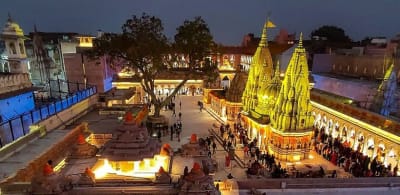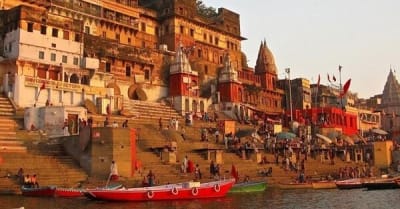Kashi vishwanath mandir
Kashi Vishwanath Mandir
The Kashi Vishwanath Temple is a famous Hindu temple dedicated to Lord Shiva. Located in Varanasi, India, it's considered one of the holiest cities in Hinduism. Millions of devotees visit the temple each year, making it a major pilgrimage destination. The temple is known for its gold-plated spire and its location on the banks of the Ganges River.
History of the Temple

According to the legends, the temple's beginning is a mystery. The Skanda Purana suggests Lord Shiva himself manifested the Jyotirlinga (celestial light column) here. Another legend associates the temple with the origin story of Varanasi, where Lord Shiva appeared as Vishwanath (Lord of the Universe) and pledged to reside eternally.
Kashi Vishwanath Temple holds immense significance as one of the twelve revered Jyotirlinga shrines dedicated to Lord Shiva across India. Jyotirlingas are considered to be the most sacred abodes of Shiva, each representing a celestial light column. This association imbues Kashi Vishwanath Temple with immense spiritual power and significance for devotees.
The temple's history is marked by the patronage of various rulers. While historical evidence suggests a temple existed on this site as early as the 11th century BCE, concrete evidence emerges around the 6th century CE. Over the centuries, the temple witnessed destruction and reconstruction multiple times, a testament to the enduring spirit of its devotees.
The first major setback came in the 12th century when a Muslim ruler, Qutb-ud-din Aibak, destroyed the temple. A Gujarati merchant rebuilt it soon after, but it faced demolition again during Sultan Sikandar Lodi's reign in the 15th century. Despite these setbacks, the temple was rebuilt by Raja Man Singh and Raja Todar Mal during Mughal emperor Akbar's reign.
The darkest chapter arrived in the 17th century under Mughal emperor Aurangzeb. A staunch Muslim, he destroyed the temple in 1669 and built the Gyanvapi Mosque in its place. The remains of the original temple can still be seen in the foundation, columns, and rear part of the mosque.
Despite these challenges, Kashi Vishwanath Temple stands tall as a testament to the unwavering faith of Hindus. Each reconstruction signifies the enduring spirit of Hinduism and the importance of preserving its traditions. In the 18th century, a Hindu queen, Ahilyabai Holkar, built the present structure adjacent to the mosque, showcasing the enduring spirit of devotion.
Significance of the Temple

First and foremost, it's a revered abode of Lord Shiva, one of the principal deities in Hinduism. Devotees believe that a visit (darshan) here brings immense blessings, removes obstacles from life, and fulfills wishes. Many Hindus consider visiting Kashi Vishwanath Temple, especially during auspicious occasions like Shivratri, to be a pinnacle pilgrimage experience.
Adding to its spiritual power is the temple's status as a Jyotirlinga. Jyotirlingas are considered to be the most sacred abodes of Shiva, each representing a celestial light column. Devotees believe that seeking blessings here allows them to connect with the cosmic energy of Lord Shiva.
Furthermore, the temple's location in Varanasi, considered the holiest city in Hinduism, further elevates its significance. Devotees believe that performing rituals and seeking blessings here hold immense spiritual value and can help attain moksha (liberation from the cycle of rebirth). Kashi Vishwanath Temple is seen as a powerful gateway to this liberation.
Another reason for the temple's significance is the belief that dying in Varanasi, especially after visiting Kashi Vishwanath Temple, can liberate one from the cycle of rebirth. This belief attracts many elderly Hindu pilgrims seeking spiritual release.
Finally, Kashi Vishwanath Temple transcends caste and socioeconomic barriers. Devotees from all walks of life come here to seek blessings, creating a powerful sense of unity and spiritual connection.
Architecture of Kashi Vishwanath

The Kashi Vishwanath Temple has been changed throughout history, but it remains a beautiful structure. Here's a look at its key features:
- The most eye-catching part is the tall, pyramid-shaped tower called the shikhara. It's covered in gold and reflects the North Indian architectural style.
- Unlike some South Indian temples, Kashi Vishwanath is a smaller complex built within the narrow streets of Varanasi. This creates a feeling of closeness for visitors. The temple shows a mix of architectural styles. The carvings on the support beams and entryways reflect Mughal influence.
- The holiest part of the temple is the Garbhagriha, a small room where the Jyotirlinga, a symbol of Lord Shiva's cosmic energy, is located. Despite its size, the intense devotion creates a powerful atmosphere.
- The main entrance has grand silver gates, separating the outside world from the sacred space within.
- While the overall structure is compact, the temple complex encompasses other noteworthy features. The Sabha Mandap (assembly hall) boasts intricately carved pillars, while the Nrityamandapa (dance hall) showcases beautiful sculptures. These halls, though not as prominent, hint at the vibrant past of the temple complex, where gatherings, rituals, and artistic performances likely took place.
Temple Timings

- Mangla Aarti : 3:00 A.M. to 4:00 A.M.
- Bhog/Aarti : 11:15 A.M. to 12:20 P.M.
- Saptirishi Aarti : 7:00 P.M. to 8:15 P.M.
- Night Shringar/Bhog Aarti : 9:00 P.M. to 10:15 P.M.
- Night Shayan Aarti : 10:30 P.M. to 11 P.M.
Location
The Kashi Vishwanath Mandir is located in Varanasi, India. Varanasi is a holy city for Hindus and is situated on the banks of the Ganges River in the state of Uttar Pradesh.
Here is the Google Maps link : Click Here
How to Reach
By Air: Varanasi has its own airport, Lal Bahadur Shastri International Airport (VNS). Domestic flights connect Varanasi to major Indian cities like Delhi, Mumbai, Kolkata, Chennai, and Bengaluru. Once you arrive at the airport, you can take a prepaid taxi, app-based taxi (like Uber or Ola, subject to availability), or rickshaw to reach the temple. The temple is about 26 kilometers from the airport.
By Train: Varanasi is a major railway junction with excellent connectivity to different parts of the country. Trains run regularly from major cities like Delhi, Mumbai, Kolkata, Chennai, and many others. The temple is located 2-3 kilometers away. You can hire an auto rickshaw, cycle rickshaw, or taxi to reach the temple.
By Bus: Varanasi has a well-established bus network connecting it to various cities and towns within India. The closest bus stand to the temple is Chaudhary Charan Singh bus stand, which is about 3 kilometers away. From the bus stand, you can take an auto rickshaw or rickshaw to reach the temple.
Nearby Tourist Attractions

Varanasi, with its rich history and cultural tapestry, offers more than just Kashi Vishwanath Mandir. Here are some captivating nearby attractions you can explore to further enrich your trip:
- Ghats of Varanasi: The city is renowned for its sacred ghats (steps) that line the banks of the Ganges River. Take a boat ride on the Ganges and witness the spiritual rituals performed here, offering a glimpse into the heart and soul of Varanasi.
- Manikarnika Ghat: This ghat is the most famous cremation ground in Hinduism. Witnessing cremation ceremonies here can be a confronting but thought-provoking experience.
- Sarnath: Located 10 kilometers from Varanasi, Sarnath is where Lord Buddha delivered his first sermon after attaining enlightenment. Explore the Buddhist monasteries and stupas (dome-shaped structures) that stand as testaments to the rich Buddhist heritage of the region.
- Banaras Hindu University (BHU): Established in 1916, BHU is one of the most prestigious universities in India. Explore its sprawling campus and architectural marvels, offering a glimpse into India's rich academic heritage.
A Spiritual Journey Awaits
A visit to Kashi Vishwanath Mandir isn't just a tour; it's a chance to connect with your inner self. Whether you're a devout Hindu or simply curious about the faith, this historic temple offers a glimpse into a rich culture and a chance for peaceful reflection. So, pack your bags, open your mind, and embark on a spiritual journey to Kashi Vishwanath Mandir.




